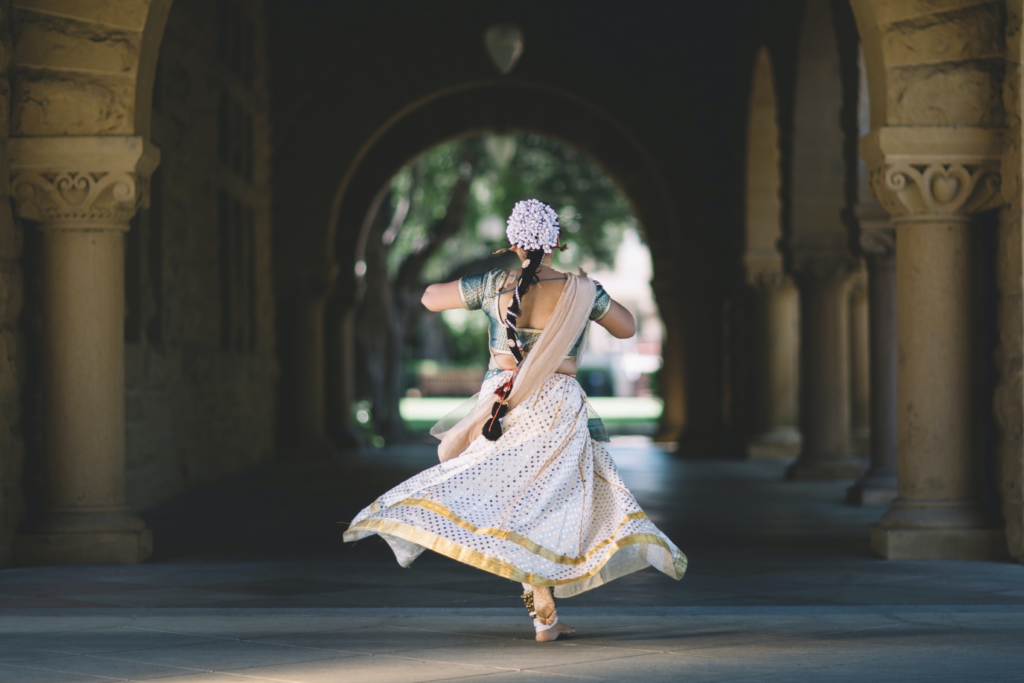Throughout history, much has been said about the female body — from how it should look and be dressed to who has the right to look at or touch it, and under what circumstances. These prescriptions not only enforce certain behaviors in women but also link their worth to their bodies. Social scientists have examined gender as a social construct. In their studies, gender refers to the typical characteristics of and distinctions between men and women. This includes norms, behaviors, and roles associated with being a woman or a man (Kaliyath 2016). The perception of gender varies across cultures and changes over time. This post focuses on how norms, behaviors, and roles associated with women throughout history were used to exert control over women and, specifically, how they influence female Indian classical dancers today.
Kathak — one of the eight forms of Indian classical dance, known for graceful hand movements, expressive use of eyes and mimetic sequences, lightning-fast footwork, and swift turns — started off as a religious storytelling method in the early medieval period in North India (Kothari 1989; Walker 2011; Walker 2012). Vedic storytellers or Kathakars traveled from place to place to communicate legendary stories, especially about the life of Lord Krishna (Shah 1998). This genre was influenced by the Bhakti movement, the trend of theistic devotion (Stoltenberg 2019). What initially began as a religious storytelling dance form turned into a dance form performed in courts during the Mughal era. Female dancers, also called nachnis/tawayifs, entertained the male audience without reference to religious or spiritual stories (Arora & Mitra 2017; Shah 1998). The court form of Kathak emphasized seductive movements and expressions danced to romantic Urdu poetry, usually sung by the female dancer herself. Shah (1998) states that:
“While Kathak, danced by the males either in the temples or in royal courts, was considered “classical,” “high art,” and Kathaks as dancers received acclaim among both the royalty and the society, tawayifs, well trained in song, dance, and poetry, were relegated to the “low art” and were socially ostracized as women of low morals.” (Shah 1998: 15)
Shortly after the Mughal era, India was colonized by the British in the 18th century. The British discouraged all classical dance forms performed by women as they viewed them as promiscuous (Walker 2012). The Indian classical dance history shows how power and control over the female body and thereby over women was exerted. Female dancers were continually seen as less than men, their talent dismissed, used for men’s pleasure, and linked to low worth and a low place in society. These norms were set by men who controlled how women were supposed to behave in order to be seen as a woman of high value. And even though we now live in a society where all of these things no longer seem to play a role, nothing is farther from the truth.
Gender scholars introduced the concept of ‘body politics’ to study the dichotomy of man and woman. Body politics implies that “the human body is itself a politically inscribed entity, its physiology, and morphology shaped by histories and practices of containment and control” (Bordo 1993: 21). Many of these theories draw on Foucault’s writing on power and knowledge and the production of subjectivity. His writing centers on the idea that knowledge is always an exercise of power and power always a function of knowledge (Foucault 1980). Many gender studies adopted his theory to study how ‘woman’ has been discursively constructed as inferior yet also threatening to man (Bailey 2002; Kruks 2018; McNay 1991). This resulted in a perpetual need for containment and control (King 2004). Control or social control in this context refers to “the authority and power to direct, command and restrain women of being able to take unilateral decisions regarding their lives” (Chanana 2001: 42).
The production of knowledge in almost every field of expertise lies in the hands of men. As a result, men had power because of the knowledge production over women. In that knowledge production, women have been measured and judged against the norm of men. Man represents “the active, strong and moral half of a human whole” (Bailey 1993: 9). Any deviation from male standard marks was seen as inferior. King (2004) argues that the idea of men and women as opposites is also reflected in polarized categories, such as mind/body, culture/nature, and spirit/matter. She further explains that:
“Man is mind and represents culture: the rational, unified, thinking subject; woman is the body and represents nature: irrational, emotional and driven by instinct and physical need. Mind/culture/man must harness and control this potentially unruly body/nature/woman through the application of knowledge and willpower” (King 2004: 31). The female body has been repeatedly regarded as something that must be contained because it is primarily a reproductive body. This is what we now know as objectification theory. This theory by Fredrickson & Roberts (1997) suggests that many women are sexually objectified and treated as an object to be valued for their use by others. Objectification implies that a woman’s body or body parts are selected and separated from her as a person. She is viewed primarily as a physical object of male sexual desire (Bartky, 1990). Consequently, women are judged by their physical appearance and that is associated with a woman’s worth, e.g., wearing revealing clothes as a woman means that she is a woman of easy virtue.
How do we see this line of reasoning back in today’s society?
Dance Gurus who have been in the dance industry for a long time have faced many obstacles. The length of a top or skirt can bring about heated discussions on what is appropriate for a girl/woman to show. The waist, legs, and shoulders can be seen as body parts that need to be covered. Little exposure can result in parents not allowing their daughters to perform on stage. Gurus have also witnessed that some parents restrict their daughters from dancing once they hit puberty and start to develop female shapes. In addition, they have experienced that when older girls get married, they are not allowed to dance anymore because their husbands or in-laws don’t find it appropriate. A married woman is supposed to focus on her married life and should not be “wasting” time on her own passions. Moreover, a married woman does not belong on stage where other men can watch her. These projected beliefs about female dancers are not limited to them alone; female Gurus themselves get judged by others and also get criticized for dancing, for example, with untied hair (Ghiraw, R.S., personal communication, 2021).
Apparently, it still is impossible to separate the female body from its reproductive function. Similar to the female Kathak performers who danced in courts and whose talents were overlooked, female dancers nowadays are still reduced to their bodies. In contrast, male Kathak performers are awarded for their talent, supported in their dance career, and never linked to their reproductive function in ways that result in discussions on what body parts to cover. The dichotomy of man and woman as it was in the old days has not changed much. It centers on the idea that men can’t control their desires and women need to be protected from that. This results in controlling women in their behavior, physical appearance, and lives – leaving them powerless and always adjusting to the opinion of others. The talent, passion, knowledge, countless practice hours, and dedication of female dancers are quickly disregarded.
Dismissing the talent and passion of girls and women because of their female bodies is highly problematic. It does not do justice to their talent nor to the art form of Indian classical dance as it is much more than entertainment. It takes years of practice, pain, frustration, studying music, religious scriptures, and the history of Indian classical dance to become a skilled and well-informed dancer. For many women, Indian classical dance is also a way of connecting with religion and spirituality. Above all, dancing brings joy and fun, allows for safe spaces to be created where women bond, and increases the self-esteem and confidence of the dancer. It’s time that we look at female bodies in a different way.
"Indian classical music and dance are not just for entertainment – they are designed to elevate your consciousness." - Sadhguru
Arora, K., & Mitra, S. (2017). Kathak: As Employed by Sanjay Leela Bhansali in Three Key Works.
Bailey, M. E. (2002). Foucauldian feminism: Contesting bodies, sexuality and identity (pp. 109-132). Routledge.
Bailey, M. E. (1993) ‘Foucauldian Feminism Contesting bodies, sexuality and identity’ in
Ramazanoglu, Caroline (ed.) Up Against Foucault: Explorations of some tensions between Foucault and feminism Routledge: London
Bartky, S. L. (1990). Femininity and domination: Studies in the phenomenology of oppression. New York, NY: Routledge.
Bordo, S. (1993) Unbearable Weight: Feminism, Western Culture and the Body University of California Press: California
Chanana, K. (2001). Hinduism and Female Sexuality: Social Control and Education of Girls in India. Sociological Bulletin, 50(1), 37-63.
Fredrickson, B. L., & Roberts, T. (1997). Objectification theory: Toward understanding women’s lived experiences and mental health risks. Psychology of Women Quarterly, 21, 173-206.
Foucault, Michel, and Colin Gordon. Power/knowledge: Selected Interviews and Other Writings, 1972-1977. New York: Pantheon Books, 1980. Print.
Ghiraw, R.S., personal communication, (27th of February 2021).
Kaliyath, S. (2016). Gender as a social construct. Qualitative Research on Illness, Wellbeing and Self-Growth: Contemporary Indian Perspectives, 362.
King, A. (2004). The prisoner of gender: Foucault and the disciplining of the female body. Journal of International Women’s Studies, 5(2), 29-39. Kothari, S. (1989). Kathak, Indian classical dance art. Abhinav Publications.
Kruks, S. (2018). 2. Panopticism and Shame: Foucault, Beauvoir, and Feminism. In Retrieving Experience (pp. 52-76). Cornell University Press.
McNay, L. (1991). The Foucauldian body and the exclusion of experience. Hypatia, 6(3), 125-139.
Shah, P. (1998). Transcending gender in the performance of Kathak. Dance Research Journal, 30(2), 2-17.
Szymanski, D. M., Moffitt, L. B., & Carr, E. R. (2011). Sexual objectification of women: Advances to theory and research 1ψ7. The Counseling Psychologist, 39(1), 6-38.
Walker, M. (2011). Bells of Change: Kathak Dance, Women and Modernity in India by Pallabi Chakravorty, Kathaka: The Tradition: Fusion and Diffusion by Ranjana Srivastava Bells of Change: Kathak Dance, Women and Modernity in India Chakravorty Pallabi Seagull Books, Calcutta Kathaka: The Tradition: Fusion and Diffusion Srivastava Ranjana D. K. Printworld (P) Ltd. , New Delhi. Dance Research Journal, 43(1), 105–107. https://doi.org/10.5406/danceresearchj.43.1.0105
Walker, M. (2012). Courtesans and Choreographers: e (Re) Placement of Women in the History of Kathak Dance. In Dance Matters (pp. 299-320). Routledge India.
Photo by Saksham Gangwar on Unsplash

